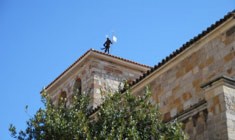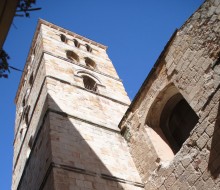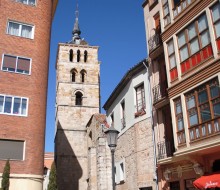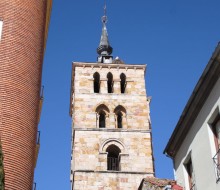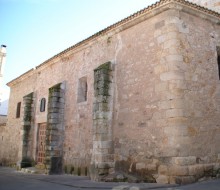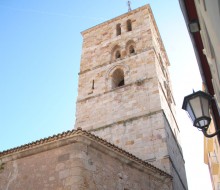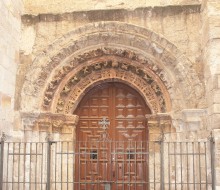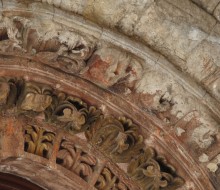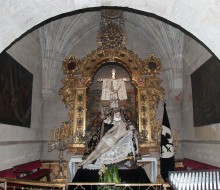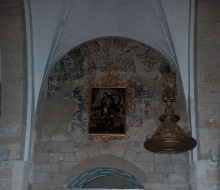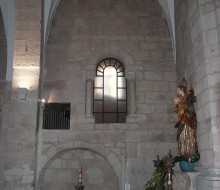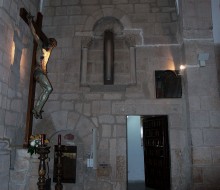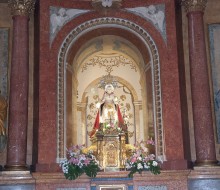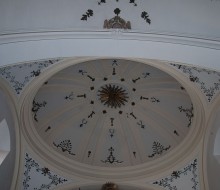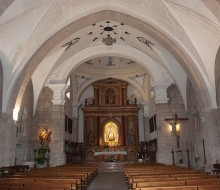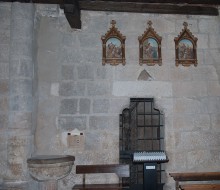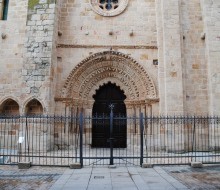Church of San Vicente
Zamora
Church of San Vicente
Zamora12th century
The Church of San Vicente (St. Vincent) was built between the late-12th and early-13th century and was modified over the years. The interior of the church is dated, in general, from the 17th century and it is topped by an 18th-century spire. Over the years this church has been hidden between buildings, preserving its beauty, though.
The original northern, western and southern walls and their doorways, as well as the tower, which stands out for its beauty and for being the most slender of the city, have been preserved. It has been classed as being of Provincial-Historic-Artistic Monument, and its western doorway and tower were also declared a National Monument in 1961.
This church is dedicated to the virgin called Virgen de las Angustias, whose brotherhood was founded in 1585. In fact, on the northern façade can be seen their shields, although it should be noted that the Virgin image is not the original one. In 1698 the chapel construction, which was built against the northern wall, was completed.
Originally this church had a basilica floor plan with three naves of four sections each, but currently it has one, with square chancel and side chapels, standing out the chapel of “Virgen de las Angustias”. The three apses were replaced in 1779 by the current head part, a work of Peter Castellote.
Inside, some of the Romanesque windows still retain that time polychromy. In the niche of the main altar is the image of the Virgen de la Concha, the patron saint of the city. In the lateral and flanked by columns can be seen the figures of St. Joseph and SSt. Anthony of Padua.
The sculpture known as “El Santísimo Cristo de la Buena Muerte”, which is housed here, is carried through the streets on Good Monday procession.
In the Chapel called “Capilla de Nuestra Madre” stands out the Baroque plaster-work ceiling and the image of the Virgin, which is carried in procession during Good Friday night. It is remarkable its stone pulpit with an eagle with outspread wings in the bowl in which, according to tradition, St. Vincent Ferrer preached in 1412, during a visit to the city.
Outside the church it is worth making special mention of the tower, which is the best preserved from this period in the city, except for the one located at the Cathedral, which was used as a model and imitated in this design. It has a rectangular floor plan and have six sections separated by cornices. It ends in a slate-roof spire, which was added in the mid-18th century.
The western doorway, which is the principal one, is particularly remarkable for its decoration. It has four archivolts and capitals adorned with plant motifs and an interior archivolt decorated with floral decoration. It looks like the southern doorway of the Church of the Magdalena. The northern doorway, partially visible in the interior, has shaved capitals with plant motifs and the southern doorway has the same features.
Exterior de la Iglesia de San Vicente
Del exterior merece la pena hacer mención especial a la Torre, que es la mejor conservada de esta época en la ciudad, a excepción de la Catedral, la cual usó como modelo e imita en sus trazas. Tiene planta rectangular y seis pisos separados por cornisas. Finaliza con un chapitel con cubierta de pizarra, que se añadió a mediados del Siglo XVIII.
La portada occidental, que es la principal, destaca sobre todo por su decoración, con cuatro arquivoltas, capiteles decorados con motivos vegetales y una arquivolta interior adornada con motivos florales. Recuerda bastante a la portada meridional de la Iglesia de la Magdalena. La portada norte, parcialmente visible en el interior, presenta sus capiteles vegetales rasurados, ocurriendo lo mismo en la portada sur.
Interior de la Iglesia de San Vicente
En esta Iglesia se venera a la Virgen de las Angustias, cuya cofradía existe desde 1585. De hecho en la fachada norte aparecen sus escudos, aunque hay que advertir que la imagen no es la original. En 1698 se terminó la capilla que se encuentra adosada al muro norte.
En el interior, algunas de las ventanas románicas aún conservan parte de la policromía de la época. En el camarín del altar mayor está ubicada la imagen de la Virgen de la Concha, patrona de la ciudad mientras que en los laterales y flanqueados por columnas se encuentra la figura de San José y San Antonio de Padua.
Antes de acceder a la capilla mayor se encuentra el Santísimo Cristo de la Buena Muerte, que procesiona el Lunes Santo. En la capilla de Nuestra Madre destacan las yeserías barrocas del techo y la imagen de la Virgen, que sale en procesión la noche del Viernes Santo. Destaca su púlpito de piedra con un águila de alas desplegadas en la taza, en el que, según la tradición, predicó San Vicente Ferrer en 1412, en una visita a la ciudad.
GET DIRECTIONS
ROUTES
OPENING HOURS AND VISITS
From 1st October until 1st March:
From Tuesday to Sunday: from 10:00 to 14:00 and from 16:30 to 18:30.
Closed on Monday.
From 1st March until 30th September:
From Tuesday to Sunday: from 10:00 to 13:00 and from 17:00 to 20:00.
Closed on Monday.
GENERAL INTEREST SERVICES
Tourist offices:
- Local tourist office: It is located at 5, Arias Gonzalo Square. Tel. +34 980 533 694
- Castilla y León tourist office: It is located at 1, Príncipe de Asturias Avenue. Tel. +34 980 531 845
- Provincial tourist office: It is located at Viriato Square. Tel. +34 980 534 047
Local police: Tel. +34 980 531 245
Civil Guard (police with responsibilities outside towns): Tel. +34 980 521 100
Emergency telephone numbers: 112
- Virgen de la Concha (Hospital): Tel. +34 980 548 212
Bus station: Tel. +34 980 521 281
Train station: Tel. +34 980 521 110
Taxi: Tel. +34 630 630 630
Civil defence: Tel. +34 980 536 190
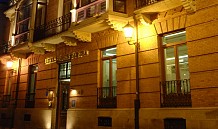
Hotel Horus
Zamora
El Hotel Horus, abierto en el año 2001, tiene un total de treinta y ocho habitaciones dobles que se dividen entre cuatro…
More info